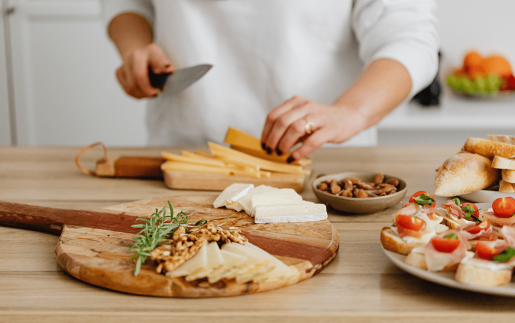Injury treatment and prevention: avoid holiday mishaps!
 After almost two years of few holiday activities and gatherings due to the COVID-19 pandemic, Americans are eager to begin celebrating and decorating. Even though this is “the most wonderful time of the year,” as the old saying goes, many dangers lurk if proper precautions are not taken. In fact, the weeks from November to January are among the busiest for urgent care centers and emergency departments.
After almost two years of few holiday activities and gatherings due to the COVID-19 pandemic, Americans are eager to begin celebrating and decorating. Even though this is “the most wonderful time of the year,” as the old saying goes, many dangers lurk if proper precautions are not taken. In fact, the weeks from November to January are among the busiest for urgent care centers and emergency departments.
In preparation for the holiday season, let’s review some of the most common mishaps – how to treat and take action if needed but, most importantly, how to avoid them in the first place.
Kitchen-Related Mishaps
With cooking and eating at the core of many holiday celebrations, it is not surprising to see a surge in cuts and fire- or burn-related injuries. Knives can cause lacerations, hot pans can cause burns and unsafe practices can lead to the spread of bacteria. Lacerations represent about 11% of holiday injuries.
Tips:
- Try to plan and not feel rushed. You’re at greater risk the more hurried you feel when preparing holiday dishes
- Don’t leave cooking food unattended
- Keep your kitchen decluttered – too many dishes covering your counter space can lead to spillage, burns and fires
- Sharpen your knives prior to use
- Have extra potholders and oven mitts ready
- Limit the occupancy and avoid overcrowding in the kitchen
- Always keep a fire extinguisher nearby
First Aid:
Burns
- First-degree burns
- Classified as superficial burns, are red in appearance and turn white with pressure
- Immediately cool the burn with cold water or ice pack
- Apply petroleum jelly or antibacterial ointment and cover with a non-stick sterile dry dressing
- Change the dressing daily and as needed
- Second-degree burns or higher
- Classified as deeper burns
- May have blistering right away, can be extremely painful unless it is a really deep burn
- Immediately cool the burn with cold water or ice back
- Apply a non-stick dressing
- Seek medical attention immediately
- Also seek medical attention immediately if you have:
- Any burns to the face, perineum, groin area greater than 3 inches in diameter
- Burns on any joint area (most commonly hand/fingers) because as these areas heal, they can cause scarring and permanent contractures
- Any chemical burn
- Any electrical burn
- Some skin is burned away
- The burn smells bad
Lacerations
- Superficial lacerations:
- If your cut looks shallow, small, clean and isn’t bleeding, you may not need to seek medical care
- For any small amount of bleeding, hold direct pressure on the cut for about 10 minutes; place antibiotic ointment on the cut and cover with a clean, dry bandage. Change daily and as needed.
- Seek medical attention if:
- You have uncontrolled bleeding and/or take blood thinners that make bleeding difficult to stop
- You have exposed muscle, fat, tendon or bone
- Bleeding continues after applying direct pressure for 10-15 minutes
- The cut has jagged or uneven edges
- Depth more than 1/8 to ¼ inches deep
- Location in a high movement or stress area (ie joints, hands, feet)
Fireplace Mishaps
Avoid these mistakes so that you can savor your time by the fire all through the winter season!
Tips:
- Clean your chimney – this is the No. 1 factor behind home heating fires
- Don’t leave the damper closed when the fire is lit
- Don’t place items or décor too close to the fire
- Choose the correct type of firewood – do not use it if it is “green” or “unseasoned”
- Don’t use lighter fluids or other flammable liquids
- Don’t burn material other than wood
First Aid:
- Always keep a fire extinguisher nearby
- Follow above tips for burn care
- For severe smoke inhalation, call emergency services for medical attention right away
Falls
Be careful when decorating! Decorating both the inside and outside of your house can pose certain dangers unless you take the necessary precautions. Unstable ladders or stepladders cause thousands of people to fall every year while decorating their homes for the holidays. Approximately 34% of decorating injuries are due to falls.
Tips:
- Don’t be afraid to ask for help – many hands make light work!
- Ask for help lifting heavy objects
- Always keep one hand on the ladder
- Ensure ladders are locked when open and that they are steady
- Keep your body within the boundaries of the ladder, don’t lean too far one way or another
- Never stand above the second-highest rung
First Aid:
- Seek medical attention after a fall if you:
- Lose consciousness
- Have persistent neck or back pain
- Have weakness or numbness in the arms or legs
- Feel severe pain in the torso or abdomen
- Have difficulty breathing
This holiday season keep your family safe, healthy and happy! Unfortunately, even the best safety plans can go awry, so it is always important to know the nearest urgent care or emergency department to your home, just in case.
By Sarah Allen, instructor and physician assistant with the Michael E. DeBakey Department of Surgery at Baylor College of Medicine.



